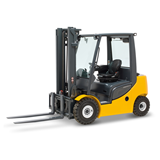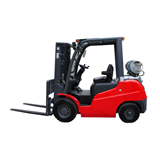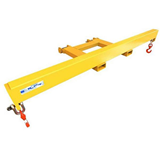Types of forklifts
Pallet Trucks
If you need to lift and carry pallets, a pallet truck could be the go for you.
- Hand pallet jack - The hand pallet truck is an extremely versatile and efficient way of moving product through your facility. Advantages include low noise and minimal operator training. They are also available in scissor lift models.
- Ride on pallet truck - To move product over longer distances a rider pallet truck is the next best option. Powered for easier use they are available in stand up or sit down.
Stackers
- Walkie Stacker - When you need to lift pallets to height the simplest option is a walk behind forklift a.k.a. Walkie Stacker. They offer extraordinary manoeuvrability and flexibility. They can be powered or manual and often the best choice when a ride on forklift isn’t necessary.
- Reach Stacker - Designed for indoor use and suited for a wide variety of applications they're perfect for weight restricted floors, elevators etc. These highly maneuverable motorised pallet trucks offer capacity and productivity without the operational cost of a rider. Available in Walkie or Reach Truck
Order picker - Often used in very narrow aisles and are particularly useful when you need to pick an order by case or piece rather than having to reach for a full pallet.
Counterbalanced Forklift - These are the most common type of forklift truck and have a weight at the rear of the truck to counterbalance the load at the tines (forks).
Rough Terrain Forklift - These are robust four wheel drive forklifts with inflatable tyres and thicker tread ideal for transporting loads over rough and sloping terrain. They can even operate in mud and snow.
Side loading Forklift - Often equipped with flat bed style forks mounted to the side. The side loader doesn’t need the turning radius of a typical forklift and they are ideal for long loads. The operator has a clear view in front and behind.
Telescopic handler - This is basically a forklift with a boom combining the best of both forklift and crane. Attachments include buckets and work platform baskets, turning it into a ‘cherrypicker’ and a hook. If the handler slews in any way a slewing licence may be required.
Tow Tractor - a.k.a. Tugger Trains are often seen towing carts along in a train, they are the workhorse of the forklift range and used at airports and freight terminals.
Features and characteristics to consider
Load Size Capacity
An underpowered forklift won’t be able to do the job and a forklift with too much power will have you paying for power you don’t need. Consider:
- The stock/material to be handled
- Average load weight
- Heaviest load to be lifted
- Width of the loads.
Reach Height
Checking your warehouse height and aisle width requirements will greatly assist you in finding the right unit.
Get to know:
- The typical lift height
- The highest point to reach
- Height restrictions, collapsed height of mast to clear doors, ceiling beams, lights, etc.
Fuel type
Forklifts with the highest load ratings are diesel and gas. Electric forklifts are suitable for most warehouse applications.
- Ideal for outdoor use
- Generally the most powerful
- Low running costs with high operational reliability
- Low fuel costs and easy storage
- Long service life
- Relatively low maintenance costs
- Choice of LPG or CNG – both are quick to refuel
- Create exhaust emissions
- Noisy in operation
- Require storage facilities for fuel
- Smooth quiet operation, ideal for warehouse and other indoor uses
- Time required for battery recharging
- Easy to move around
- Long service life
- Lower running costs but operational maintenance costs are usually higher
- Zero emissions
- Smaller motors allow more flexibility in body styles and configuration
- A 2.5 tonne capacity with most being under one tonne
- No towing capacity
- Restricted to level, even concrete or asphalt operation
Also consider the work environment & terrain
- Indoors, outdoors or both
- Smooth or rough surfaces influence tyre selection
- Fuel type
- Consider the floor surface and conditions the forklift will be working in
- How many hours of usage per day
Tyre selection
Choosing the right tyres will impact your forklift’s handling and safety. Each type of tyre has their own specific use and are suited to certain environments. Tyre pressures should be checked every month, taking into account heat buildup during use can increase pressure by 15 psi.
Solid tyres (Puncture Proof)
- The most common tyre
- No cushioning effect
- Long lasting
- Excellent for indoor or light outdoor use
- Unsuitable for rough outdoor or uneven surfaces
Pneumatic tyres
- Filled with air
- Thick, deep tread
- Strong wear-resistant rubber
- Cushioning effect between the forklift and the ground extends forklift life
- Suitable for uneven and rough surfaces
Polyurethane wheels
- General indoor use
- Small rolling resistance extends their running life
White non-marking tyres
- Prevents black marks on floors
- Required for grocery and food processing
- Short life span
Cushioned tyres
- For smooth pavements and warehouses with concrete flooring
- Smaller turning radius than pneumatic tyres
Foam filled tyres
- Filled with resin providing constant pressure
- Provides a cushioning effect whilst preventing punctures
Ergonomics
Forklift operators can be sitting in their machines for hours at a time. High quality adjustable seating lessens the likelihood of injuries caused by repetitive tasks performed using uncomfortable seating.
New or used
A new forklift will be much more suitable if it's to be used for more than four hours per day. If the forklift is to be only used sporadically for an hour or two then a quality used machine may be the most cost effective option.
After sales service/maintenance
Can vary hugely between brands depending on parts availability and pricing.
Conclusion
When choosing a forklift it’s important to consider which forklift best suits your application, taking into account dimensions material being moved, weight, height of reach, operating surfaces and special needs. In many cases OHS regulations may dictate a requirement for reverse alarms, strobe lights, special licences and/or safety equipment to be used.
Choosing the right supplier
With a better understanding of your forklifts needs, it's now time to find a supplier you can rely on. Here are some things to assess:
- Your timeframe and budget - can the supplier meet these needs
- Experience with your specific challenge
- Can you speak with other customers about their experience with the supplier
- How long have they been in business and do they service your location effectively
- Their financial stability and reliability. Consider a credit check and/or site visit
- How responsive and professional have they been during the quote process - This can be a good indication of their reliability for the future
- What standards do they adhere to
- Is equipment in stock, otherwise what are the lead times
- What sort of expertise is needed to operate the equipment
- What sort of maintenance plans is provided and the costs
- Costs for service and repair
- Costs for parts and accessories
- Support availability and willingness to be a partner in developing and optimising for the future

.jpg)


-160x160-state_article-rel-cat.png)











